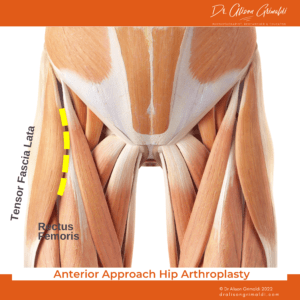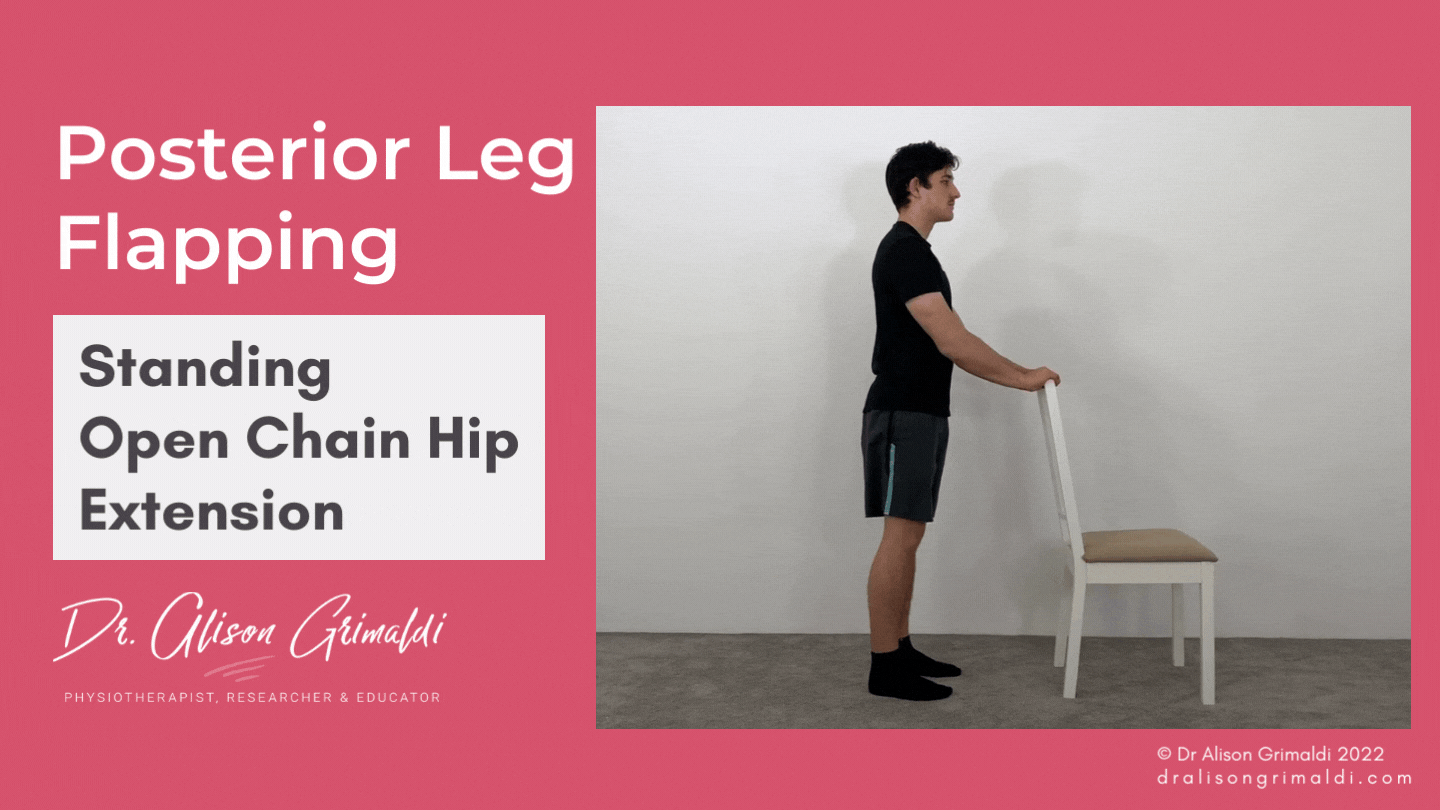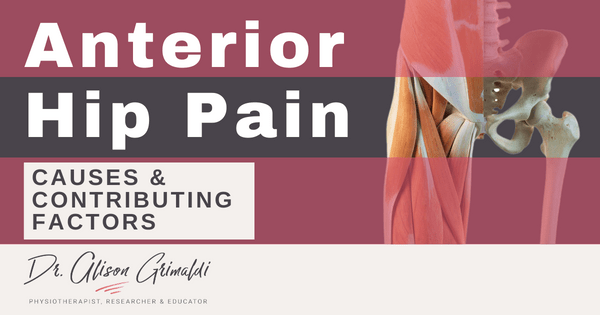Flick the Flap after hip replacement

During our most recent Hip Academy live member meeting, we were discussing the types of exercise protocols used for post-operative rehabilitation after total hip arthroplasty (hip replacement surgery). I wasn’t sure if it was just my local experience but after discussing the issues with members from across the globe, it does appear that the ‘cookie-cutter approach’ to post-operative exercise programs for hip replacement still has a stranglehold. This seems particularly so, for programs prescribed in the early post-op period in hospital. For some patients, this is the only physiotherapy they will receive, so we really have a duty-of care to ensure we are providing safe, high-value exercise programs. At the end of our Hip Academy meeting, I was encouraged by one of my colleagues to shine a light on this issue, so here it is, my call to ‘Flick the Flap after Hip Replacement!’
What does that mean? Flick the Flap? We’ll get back to that, but first a brief look at the success of exercise interventions for rehabilitation or prehabilitation for total hip arthroplasty, and why we might need to rethink our programs.
How successful is prehabilitation and rehabilitation for hip replacement?
The authors of one of the most recent systematic reviews on this topic were able to perform a meta-analysis on 26 studies with 1004 patients that used land-based exercise in hip prehabilitation or rehabilitation following total hip replacement.1 Their primary conclusions were as follows:
- ‘Compared with usual care or no or minimal intervention, supervised exercise interventions were not associated with improved self reported physical function.’
- ‘These findings suggest that supervised preoperative and postoperative exercise interventions are probably not necessary for patients with total hip replacement.’
Such conclusions always make my heart sink. Should all patients now be advised that pre and post operative exercise for hip replacement is ‘not necessary’? Sure, some patients with higher baseline level of function and/or lower physical post-operative requirements, may manage adequately with removal of the offending joint and some simple advice. However, from what we are seeing in current clinical practice, this would seem to be the exception rather than the rule, particularly with increasing numbers of younger patients with higher expectations and needs undertaking total hip replacement.
When interpreting the results and conclusions of this recent systematic review, we need to consider the limitations of the review conclusions:
- The level of certainty of the evidence was very low-moderate.
- There were no studies with a low risk of bias.
- There was large heterogeneity in programs – exercises, intensity, frequency, duration.
- There was a lack of adequate compliance data – we don’t even know if the patients completed most of these programs.
- Studies included spanned back to 1988.
While it might seem best practice to include all papers available, the quality of earlier papers is likely to be lower, and the patient groups 20 or more years ago may not closely match the demographics and situation of patients currently presenting for arthroplasty.
What type of patients are now presenting for total hip replacement?
There appears to be much greater heterogeneity in the patients we have been seeing more recently for rehabilitation pre or post total hip replacement. There are a couple of groups that stand out, who might be particularly in need of high-quality rehabilitation:
1. The older patient with poor quality-of-life and physical health after extended wait times for hip replacement surgery
Particularly in the public health system, patients may be waiting longer and be at a lower level of conditioning prior to surgery, and only be afforded 3 days of in-hospital stay. With the aging population and rising demands on health systems that are struggling to keep up, wait times have been on the rise in many countries. The Covid pandemic catapulted our health systems into a situation of massive delay for ‘elective surgeries.’ A UK nationwide survey of patients waiting for total hip arthroplasty was published last year, comparing Quality of Life in the 2020 cohort to a control cohort from 2014 – 2017.2 The 2020 group had a significantly worse EQ-5D (Quality of Life outcome measure) score compared to the control group and over 1/3 (35%) of the 2020 cohort rated their quality of life as less than 0, defined as a health state ‘worse than death.’ Over 80% of this group felt that their quality of life had deteriorated while waiting, and time spent on the waiting list was independently associated with a decrease in quality-of-life.2
Patients waiting for extended periods for surgery, who are told that ‘there is nothing that can be done except take medications to manage the symptoms and wait for the surgery’ may develop greater losses in physical capacity, range of motion and muscle health and function. Can we then compare these patients to participants of studies that are 15-20 years old? The baseline capacity may well be much lower, meaning that there may be much more to gain from physical therapies and particularly exercise interventions and individualised advice.
2. The younger patient with higher physical needs and expectations following hip arthroplasty
In recent times, we have also increasingly been seeing much younger patients undergoing hip replacement, with much higher expectations and physical needs and goals. Advancements in materials and surgical technique has made this possible. Prosthetic materials have advanced substantially in the last couple of decades, with much higher tolerance to physical loads and resistance to wear. Patients can often return to high demand physical pursuits, and given the opportunity, would much prefer to reclaim their quality-of-life rather than sit on the sidelines of their life for a decade or more, waiting to be ‘old enough for surgery.’ Surgeons have worked to find ways to reduce rates of dislocation, early revision and impact on soft tissues, through prosthetic choice and surgical technique. Have we seen comparable advancement in post-operative rehabilitation?? Or are these younger patients being provided with the same cookie cutter program, often delivered only online or on paper, as their 70+ year old counterparts?
Ok, ok, I’m getting there! So, what’s all this about Flick the Flap? Flick the Flap after hip replacement is my call for physiotherapists and other rehabilitation professionals to choose safe, high-value exercises after hip arthroplasty … and flick the long standing, low-value components of traditional programs, particularly what I refer to as the ‘Leg Flapping’ exercises.
Flick the Lateral Flap after Hip Replacement – Standing Hip Abduction
Standing open-chain (foot off the floor) hip abduction (lateral leg flapping) is a traditional staple in most post-operative programs after total hip replacement…and pre-op programs for that matter.

Does lateral leg flapping deserve a place in our post-op programs?
Does it tick enough of our early post-op goal boxes?
What do we really want to achieve in that first few weeks after hip replacement?
- Graduated restoration of function
- Re-establish efficient movement patterns
- Re-establish efficient muscle recruitment patterns
- Active ranging through appropriate ranges for surgical approach
- Avoid excessive loads on healing scar
What about strength & hypertrophy training after hip replacement?
Strength will naturally begin to restore post op with optimisation of muscle and movement efficiency, reductions in pain and fear, and increases in functional task performance and confidence. What about hypertrophy? Yes, we’ll certainly be aiming for hypertrophy, but this is not likely to be our priority in the first few weeks after major arthroplastic surgery. Research has shown that progressive resistance training early after total hip arthroplasty does not differ significantly from standard rehab in terms of recovery of functional capacity and muscle strength.3
We may be better off focusing on the foundations listed above in those early weeks while those soft tissues are healing. Particularly for anterior approach surgeries where the entry point is between the Tensor Fascia Lata (TFL) and the Rectus Femoris. High activation of the TFL during an abduction action early post op may create unfavourable transverse loads on anterior healing tissues. There are no studies that have explored the impact of specific exercises on healing soft tissues post-arthroplasty, but it's something we should consider, particularly for the anterior approach surgeries that appear more likely to have issues with soft tissue post-operatively.

What are the best hip abductor exercises after hip replacement?
In the literature, exercises that induce highest electromyography (EMG) levels are often inferred to be the ‘best.’ However, muscle force cannot be directly inferred from EMG levels,4 and high EMG may be due to activation in a position of poor mechanical efficiency. In a sophisticated synergy such as the hip abductor synergy, EMG from 1-2 members of the synergy and particularly surface EMG studies do not provide an adequate representation of the function of that muscle group as a whole. In addition, almost all EMG studies that have been undertaken to determine the ‘best exercise’ for abductor strengthening have been performed on healthy individuals with no impairments.
We know from the literature that fatty atrophy does not occur consistently across all abductor muscles in those with hip osteoarthritis (OA). Even in late-stage OA, significant muscle atrophy occurs in gluteus minimus, medius and maximus but not TFL,5 meaning that the TFL will account for a relatively larger percentage of the overall abductor muscle volume. It would then follow, that rehabilitative efforts to address specific deficits would be directed towards exercises that stimulate the gluteals, with relatively less stimulus of the TFL.
As I have discussed previously, while the TFL works strongly in open-chain exercise, the gluteals appear to be particularly influenced by weightbearing stimulus.6 Weightbearing stimulus for the gluteals is likely to be even more important for those with hip pain, who have atrophy in these deeper abductors and relatively increased contribution from the TFL. Patients with abductor dysfunction left to mindlessly flap their leg into abduction, tend to drift into flexion and accomplish the task with high levels of TFL activation. The weightbearing leg will arguably be receiving a far superior stimulus. Addressing abductor impairments may be better achieved then with the weightbearing side of the exercise. Single leg standing or hip hitch style exercises have been shown to produce high recruitment of gluteus minimus and medius.6,7 Graduated loading of the trochanteric abductors can also be achieved by progressing through closed-chain loading progressions: isometric abduction in standing, bridging and squatting variations – double leg, offset, adding external load, single leg. Closed chain frontal plane loading can also be achieved in sidestepping, side-sliding and reformer-based standing abduction.

Flick the Posterior Flap after Hip Replacement – Standing Hip Extension
Abduction flapping is not the only form of flapping prescribed to most patients within their early post-op rehab program after total hip replacement. Posterior leg flapping - standing open-chain hip extension - is another mainstay of traditional programs.

This form of leg flapping is perhaps even more concerning when it is applied indiscriminately, without consideration of surgical approach. Anterior approach arthroplasty of course involves opening and then repairing the anterior capsule. As with any capsular repairs, the healing usually takes around 3-4 months to form a solid scar. It is during this timeframe that the risk of dislocation is usually highest. For anterior approach surgeries, the highest risk of overloading the healing capsule is in a position of hip extension, or end-range external rotation or a combination of these actions. So, this does question the rationale for asking the patient to lift their hip into end range extension, with the active gluteus maximus creating an anteriorly directed force. Sure, during gait the patient may be moving through 10 degrees of hip extension or so, but at late stance-phase, gluteus maximus activation is low and hip flexor and anterior gluteus minimus activation is high. This is efficient and protective for the hip joint, reducing and controlling anteriorly directed forces at late stance phase. This risk of dislocation after an anterior approach total hip replacement is admittedly low, 1 in every 100-150 people.8 However, early dislocation and possible revision surgery can be devastating for that patient, with extended recovery, poorer outcomes, and the loss of that ‘promise’ of a rapid restoration of function and quality of life. Is the risk really worth it? Let’s flick the flap after hip replacement.

There are again, so many other high-value options for loading the gluteus maximus muscle. Glute max has poor mechanical efficiency in inner range extension, which may result in high EMG levels but poorer torque production. This muscle has much greater mechanical efficiency in mid-range flexion and functions primarily as a weightbearing extensor, working with the knee extensors to get us in and out of our chairs, squat, lunge and climb stairs, and to lift our bottoms to move in bed. These are the things our patients really want and need to do. Such functional exercises, even with bodyweight alone, create high levels of stimulus for gluteus maximus9 in efficient ranges with higher torque production capacity. These exercises are a great way to recondition the gluteus maximus, with much higher potential value and lower risk than posterior leg flapping - standing open-chain hip extension.
Flick the Flap in the Pool
Pool-based exercise is common for those with hip OA and after hip replacement, with both lateral and posterior leg flapping common elements of a pool-based program. In the pool, where gravitational stimulus is reduced, there will be even less natural stimulus for the gluteals and potentially more possibility of TFL dominance in abductor loading tasks. I ask my patients doing pool programs to swap out the leg flapping for other tasks that focus on foot contact with the pool floor:
- Try swapping lateral leg flapping with sidestepping, with the focus on a controlled push from the trail leg. This can even be a step-tap action on one spot for group classes.
- Try swapping posterior leg flapping with squat variations or step ups with the focus on heel pressure.
- Try moving to the shallower end of the pool to achieve more heel contact with the pool floor and gravitational stimulus.
In a busy clinical environment, where staffing levels are in many places becoming relatively lower for the number of patients that need assistance, it is often easiest to rely on a standard protocol. However, the traditional standard protocol for post operative rehabilitation after hip arthroplasty may be due for some revision. The patient population and their needs are changing, and our knowledge of muscle function has progressed. It’s time to move on and to give our patients the best chance of achieving their functional capacity and quality-of-life goals. I hope this has provided some food for thought and some alternative exercise ideas that might help to Flick the Flap after hip replacement.
If you are keen to hear more about prehabilitation & rehabilitation considerations for hip arthroplasty, Hip Academy members can watch the recording of our recent meeting on this topic.
HIP ACADEMY MEETING TOPIC:
Prehab & Rehab for Hip Arthroplasty
Prehab & Rehab for Total Hip Arthroplasty.
-
- the importance of rehab in the later stages of OA/prehab prior to arthroplasty
- key things we aim to maintain prior to surgery & strategies to achieve these
- how type of surgical approach influences your post-operative management
- precautions and priorities through different phases
- considerations for exercise selection
Another great Anterior Hip Pain blog

Anterior Hip Pain: Causes & Contributing Factors
Adequate consideration of individual causes and contributing factors is important for best outcomes.
References
- Saueressig T, Owen PJ, Zebisch J, Herbst M, Belavy DL. Evaluation of Exercise Interventions and Outcomes After Hip Arthroplasty: A Systematic Review and Meta-analysis. JAMA Netw Open. 2021 Feb 1;4(2):e210254.
- Clement ND, Scott CEH, Murray JRD, Howie CR, Deehan DJ; IMPACT-Restart Collaboration. The number of patients "worse than death" while waiting for a hip or knee arthroplasty has nearly doubled during the COVID-19 pandemic. Bone Joint J. 2021 Apr;103-B(4):672-680.
- Chen X, Li X, Zhu Z, Wang H, Yu Z, Bai X. Effects of progressive resistance training for early postoperative fast-track total hip or knee arthroplasty: A systematic review and meta-analysis. Asian J Surg. 2021 Oct;44(10):1245-1253.
- Hug F, Hodges PW, Tucker K. Muscle force cannot be directly inferred from muscle activation: illustrated by the proposed imbalance of force between the vastus medialis and vastus lateralis in people with patellofemoral pain. J Orthop Sports Phys Ther. 2015 May;45(5):360-5.
- Zacharias, A., Green, R., Semciw, A., English, D., Kapakoulakis, T. and Pizzari, T., 2018. Atrophy of hip abductor muscles is related to clinical severity in a hip osteoarthritis population. Clinical Anatomy, 31(4), pp.507-513.
- Moore, D., Semciw, A. and Pizzari, T., 2020. A systematic review and meta-analysis of common therapeutic exercises that generate highest muscle activity in the gluteus medius and gluteus minimus segments. International Journal of Sports Physical Therapy, 15(6), pp.856-881.
- Ganderton C, Pizzari T, Cook J, Semciw A. Gluteus Minimus and Gluteus Medius Muscle Activity During Common Rehabilitation Exercises in Healthy Postmenopausal Women. J Orthop Sports Phys Ther. 2017 Dec;47(12):914-922.
- Tay K, Tang A, Fary C, Patten S, Steele R, de Steiger R. The effect of surgical approach on early complications of total hip arthroplasty. Arthroplasty. 2019 Sep 3;1(1):5.
- Macadam P, Feser EH. Examination of gluteus maximus electromyographic excitation associated with dynamic hip extension during body weight exercise: A systematic review. Int J Sports Phys Ther. 2019 Feb;14(1):14-31.


